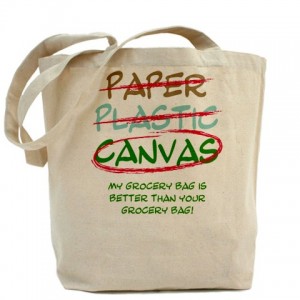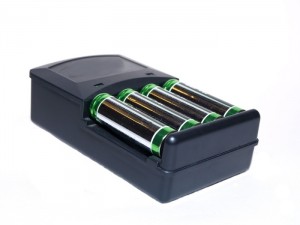With Halloween right around the corner and Thanksgiving, Hanukkah, Christmas and other holidays quickly approaching, retail stores are gearing up for their busiest time of year. Consumerism in the United States is at an all time high during the last quarter of the year, and most Americans will spend an average of 42 hours shopping, wrapping, and visiting friends and family to exchange gifts and celebrate the holidays (Consumer Reports National Research Center).
With a struggling economy and increasing awareness about how the choices we make as consumers can affect our local ecosystems, the U.S. Green Chamber would like to share some simple, yet effective tips to help guide you through the hectic holiday season.
REUSEABLE SHOPPING BAGS
Whether you are making a trip to your local grocer or having a heyday at the mall this holiday season, bring reusable, cloth bags with you for your purchases. Thousands of paper and plastic bags are thrown into landfills every year, and those numbers increase as spending increases during busy seasons. Small purchases can be carried in a purse or by hand and large purchases often don’t need bags at all.
DITCH THE WRAPPING PAPER
Instead of using endless yards of hard-to-recycle wrapping paper, try to find alternative methods for wrapping gifts. Paper gift bags are often easier to re-use than wrapping paper. Cloth bags are an even better option, as is cloth wrapping paper; one great website offering cloth wrapping materials is furoshiki.com. If you must use paper, try to save it when unwrapping. There are many stores offering recycled wrapping products too. Try to purchase items that are smaller and easier to wrap such as gift cards or concert tickets.
ELECTRONIC GIFT CARDS
Instead of sending paper greeting cards in the mail, consider sending e-cards instead. Let recipients know of your intentions when you send them. Not only will you be saving paper but also helping to reduce the total amount of mail the USPS has to sort and ship this holiday season. If you do receive paper cards, save and reuse them as gift tags the following year. Merry-go-Round Cards and Slingshot Cards are other good options.
If you are buying electronic gifts for people include rechargeable batteries. About 40% of all battery sales occur during the holiday season. By encouraging your friends and family to use rechargeable batteries you are reducing the amount of harmful materials thrown into landfills and potentially saving them money in the long run.
RECYCLE YOUR CHRISTMAS TREE
About 33 million Christmas trees are sold each year in the U.S. Check with your local recycling center or a waste management center to see if they have programs in place to mulch trees and reuse that material for hiking trails or parks. Alternatively, buy a live tree and plant after the holiday season. Find tips for maintaining a live Christmas tree here.
MAKE YOUR OWN DECORATIONS AND GIFTS
Instead of purchasing flimsy or disposable holiday decorations made from cardboard or plastic, consider making more durable and lasting decorations and gifts. Throw a party with friends where everyone brings in old materials such as clothing, beads, jewelry, etc to create festive and unique decorations. Making your own food-based gifts from bulk products is another great idea, just be sure to package your food items in reusable containers.
PLAN AHEAD FOR PARTIES AND HOLIDAY MEALS
A lot of food and disposable eating utensils are thrown into landfills each holiday season–reduce the amount of waste you produce by planning ahead. Be sure to get an accurate head-count for your parties and events, try to estimate how much people will consume and purchase food accordingly. Encourage guests to bring their own reusable containers to bring leftovers home. Avoid using plastic or paper disposables, if you are throwing a large party find a service that can lend you dishes, cloth napkins, and silverware. As a last resort, buy disposables that are compostable and set up a compost in your home, office, or party venue to properly dispose of materials.
GIVE ALTERNATIVE GIFTS
Think about the people you are buying gifts for and consider giving alternative gifts this season instead of more traditional things like clothing, books, toys, and electronics. Giving a donation to a non-profit in someone’s name is a great way to reduce your environmental impact and help someone truly in need at the same time. Giving the gift of your service is another great way to reduce waste–mow a friend’s lawn, offer babysitting services, wash your neighbor’s car, or walk their dog. The possibilities are endless, and often people will appreciate your creativity more than yet another fruitcake or holiday sweater.
Try to reduce the total amount of lights you use on your tree and around your home this season. Make sure to use timers so that lights are only turned on when the sun goes down and automatically shut off when you go to sleep at night. Buy LED lights instead of traditional lights–LEDs use about one-tenth of the energy that traditional, incandescent bulbs use. LEDs also last a lot longer than other varieties.
When cooking try to time your meal so that everything is in the oven at the same time. Microwaves use considerably less energy than traditional ovens.
KEEP THE CAR IN THE GARAGE
Walk, ride your bike, or take public transportation. We all know that the holidays are notorious for weight gain in the United States. Finding alternative transportation will not only reduce your carbon emissions but it can help you stay fit too! Who wants to battle those crazy parking lots during the holidays anyway?
The holidays are sometimes stressful for individuals, but that doesn’t mean it has to be a major stressor on our local ecosystems. With a little bit of foresight and planning you can significantly reduce your environmental impact this holiday season and feel good about the choices you make as a consumer and gift-giver. Many of these tips can actually save you time and money too!










